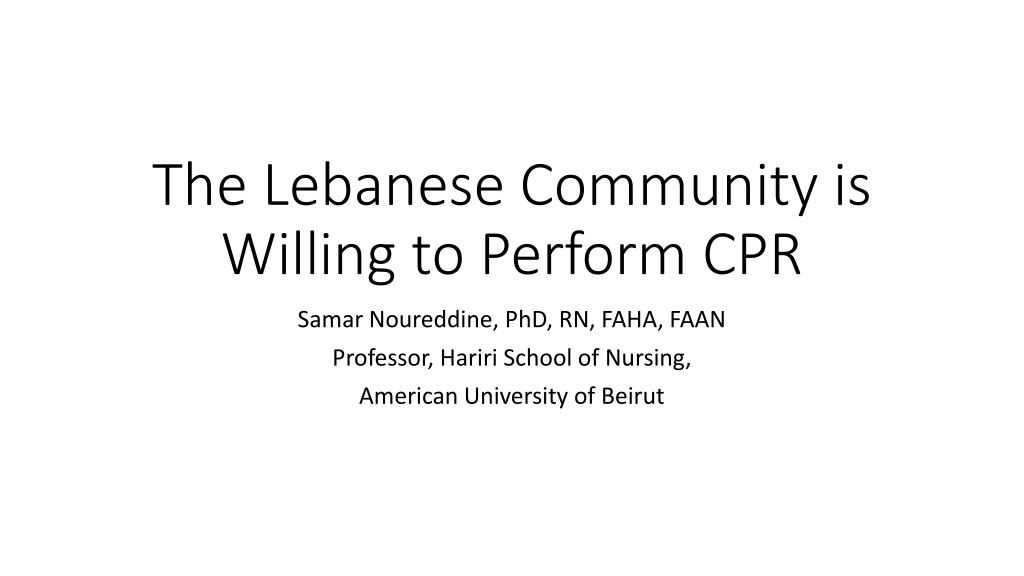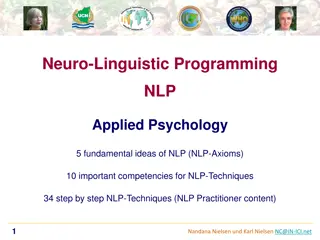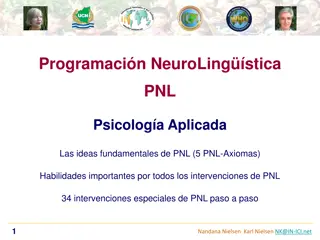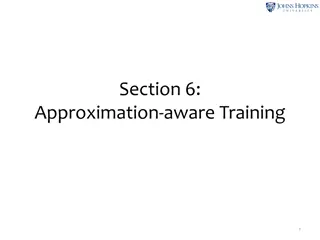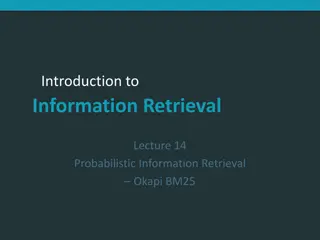Language Modeling and Probabilistic Independence in NLP
In this lecture on natural language processing, topics such as language modeling, probabilistic independence assumptions, smoothing techniques like Laplace smoothing, Markov assumption, bigram probabilities estimation, and perplexity are discussed. The lecture delves into the fundamentals of NLP and how these concepts play a crucial role in understanding and enhancing language processing algorithms.
Download Presentation

Please find below an Image/Link to download the presentation.
The content on the website is provided AS IS for your information and personal use only. It may not be sold, licensed, or shared on other websites without obtaining consent from the author.If you encounter any issues during the download, it is possible that the publisher has removed the file from their server.
You are allowed to download the files provided on this website for personal or commercial use, subject to the condition that they are used lawfully. All files are the property of their respective owners.
The content on the website is provided AS IS for your information and personal use only. It may not be sold, licensed, or shared on other websites without obtaining consent from the author.
E N D
Presentation Transcript
The Lebanese Community is Willing to Perform CPR Samar Noureddine, PhD, RN, FAHA, FAAN Professor, Hariri School of Nursing, American University of Beirut
Introduction Survival of out-of-hospital cardiac arrest victims in Lebanon is 4.8% - 5.5%, with only 45.4% presenting good neurologic outcomes (El Sayed et al., 2014, 2017) Globally, survival is ~ 10%. Half of the arrests are witnessed by a bystander. ~ 70% occur at home, 20% in public places and 10% in nursing homes (Eisenberg et al., 2015; El Sayed, 2017). 5.5 ( % 10 % ) 4.8 . 20 % 10 The chain of survival of out-of-hospital cardiopulmonary resuscitation (CPR) starts with the witness/bystander who calls for help and starts CPR . High quality CPR is associated with improved survival outcomes (AHA, 2018) Early bystander CPR and early defibrillation are also important factors in improving patient outcomes (Chan et al., 2014) % 70 %
Why Train the Community in CPR? Resuscitation Academy )2008( in Seattle, Washington, USA, to improve cardiac arrest survival. Offered didactic lectures, demonstrations, hands-on breakout sessions, and workshops, in addition to providing AEDs in public places. The results were: Bystander CPR increased from 62% in 2011 to 75% in 2014 Survival to discharge of arrest victims increased from 36% to 46% Intact survival increased from 32% to 43% In Denmark bystander CPR increased from 19% to 65% and survival from 4% to 12% between 2001 and 2013 following initiation of community CPR training. : % 62 % 75 % 46 % 36 32 % 46 % 19 : % % 65 % 12 % 4
Do we Need to Train the Community in CPR in Lebanon? Survey of 75 emergency physicians. What must be done to improve out-of-hospital resuscitation survival? Provision of automated external defibrillators (AEDs) in public places: 26.6% Provision of community training in CPR: 25.3% Organizing awareness campaigns for the recognition and management of cardiac arrest (20.3%) Developing a national policy on out- of-hospital resuscitation that explains the duty of lay people (15.1%). 75 % : 25.3 26.6 % : AED % 20.3 15.1 % : (Noureddine, Avedissian, Isma eel, & El Sayed, 2016)
Do we Need to Train the Community in CPR in Lebanon? ( Haidar, Noureddine, Osman, Isma eel & El Sayed, 2018) 258 Survey of 258 emergency medical technicians. What must be done to improve out- of-hospital resuscitation care and survival? Training citizens in resuscitation: 79.1% Developing a policy on out-of-hospital CPR that addresses the duty of lay persons in resuscitation: 73.2% Adjusting traffic laws: 52.0% Developing a policy that addresses liability/legal aspects: 41.5% % 79.1 : 73.2 % 52 % : : : % 41.5
Is the Lebanese Community Willing to Perform CPR-The view of Nurses? ( Noureddine, Avedissian, Al Khatib and Irani, 2019) ( ) 691 Survey of 691 nurses who work in hospitals and primary health care centers 56.5 3 % % 95.9 95.9% received CPR training, but 56.5% had it up to 3 times only, and 21.9% had their most recent training over 2 years ago. When asked how often did they participate in CPR in an out of hospital arrest that they witnessed, 78% reported having participated, including 16.8% always, 25.2% most of the times and 36% sometimes. % 21.9 % 78 % % 16.8 25.2 36 %
Is the Lebanese Community Willing to Perform CPR-The view of Nurses? ( Noureddine, Avedissian, Al Khatib and Irani, 2019) Nurses are willing to do CPR in the community if the victim was: A stranger: 96.51% A trauma victim: 80.80% A child younger than 12 years: 88.23% An older adult (older than 65 years): 96.19% A relative or close friend: 90.52% Predictors of willingness to perform CPR on a stranger: Frequency of CPR practice and fear of being sued. Is community training in CPR necessary? 82.1% -> very necessary 16.2% -> moderately necessary. : 12 65 % : 82.1 : % 16.2
Is the Lebanese Community Willing to Perform CPR-The view of Nurses( Noureddine, Avedissian, Al Khatib and Irani, 2019) What factor is important in your decision to do CPR in the community ? Having received CPR training: 92.2% Having courage: 80.0% Having had recent CPR practice: 76.6% Presence of a national policy/guideline on CPR: 73.4% Fear of catching an infection: 70.5% Hesitance to do mouth-to-mouth resuscitation: 65.7% Fear of harming the victim: 59.9% Fear of being sued: 54.4% % : 92.2 % : 80 : 76.6 : 73.4 : 70.5 % : 65.7 : 59.9 % : 54.4 % % % %
Is the Lebanese Community Willing to Perform CPR-The view of Youth ( Al Shams, Raad, Chams N, Chams S, Bachir & El Sayed, 2016) Survey of 948 students at a large private university Only 20.3% had CPR training, 51% of whom had it at school and 12.8% at the university. Only 21.7% of training included AED 87.8% believe that they should learn and perform CPR Where do you prefer to get such training? School: 44.1% Community center: 14.1% Recreational building or gym: 10.3% At home through self-learning videos: 7.2% 20.3 12.8 AED 948 % 51 21.7 % % % % 87.8 44.1 % : 14.1 % : 10.3 : 7.2 : : % %
Is the Lebanese Community Willing to Perform CPR-The view of Youth ( Al Shams, Raad, Chams N, Chams S, Bachir & El Sayed, 2016) Predictors of the students willingness to perform CPR in the community were: Having moderate income ($500 - $1,000) Having prior CPR training Having confidence in one s ability to apply AED or perform CPR : AED
Strategies to Promote Community Involvement in Out-of-Hospital CPR Legislation that facilitate community CPR (Good Samaritan Law) Mandatory CPR and AED training in schools and the community Make AEDs available in public places Begin AED program for first responders, including police, guards and security personnel Telephone CPR, i.e. CPR with ongoing training Use smart technologies to extend CPR and public access defibrillation programs to notify volunteer bystanders who can respond to nearby arrest to provide early CPR AED AED AED
